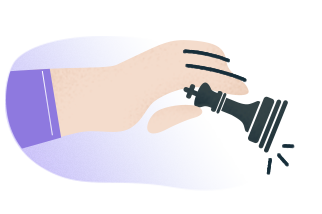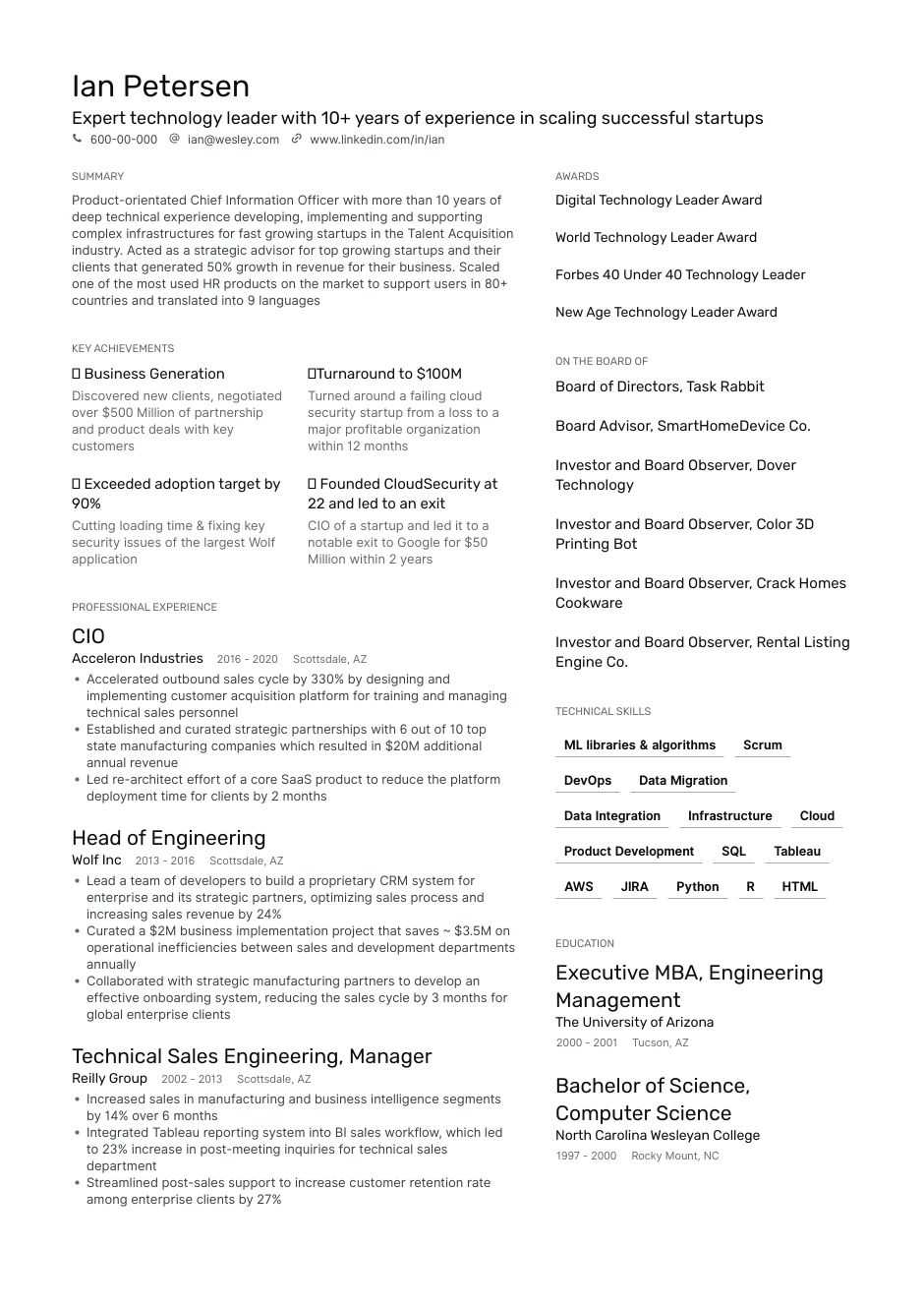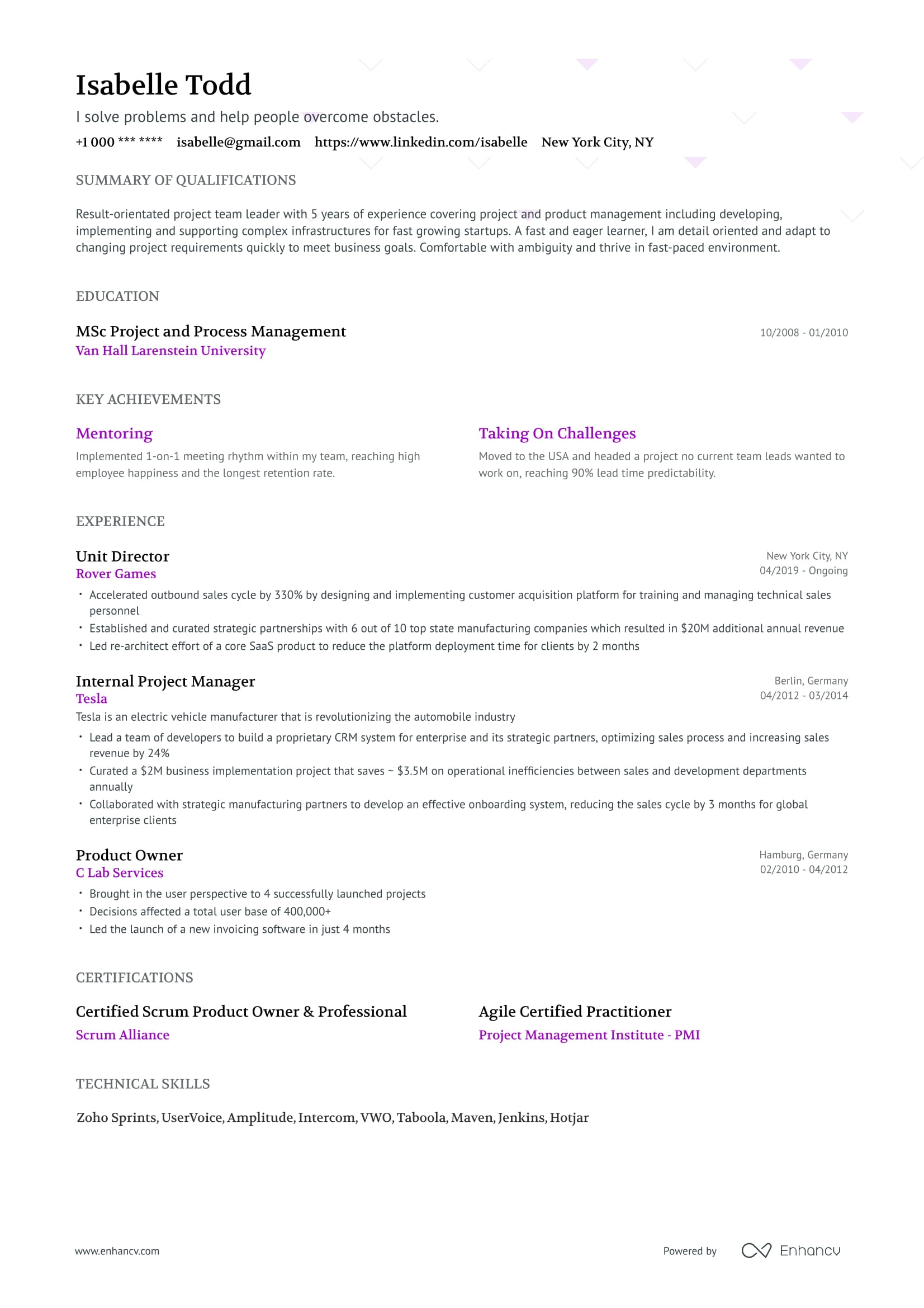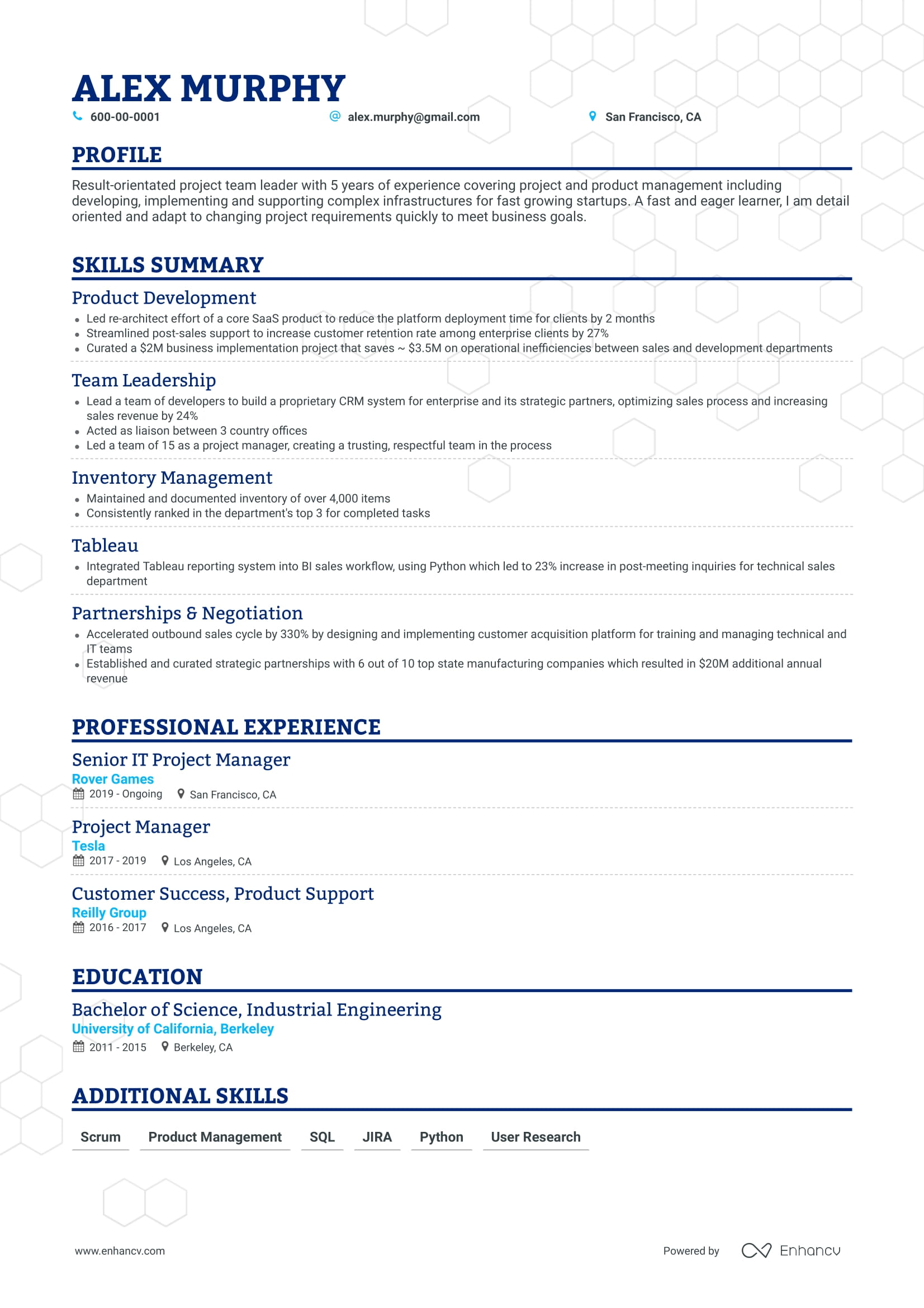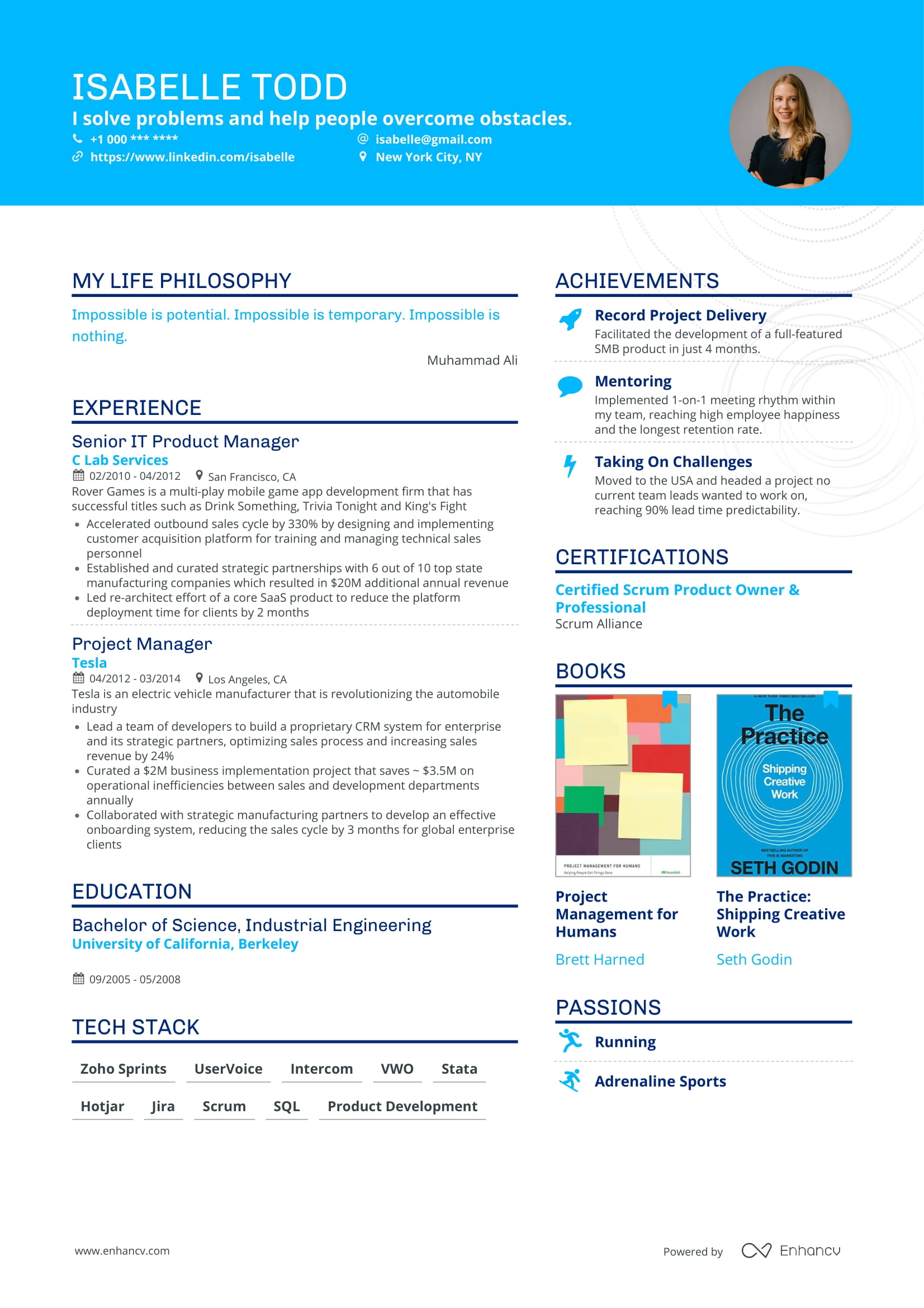Example CIO Resume - Browse more resume templates and build a stand-out resume
The world has seen a huge shift in how businesses are run in the past few decades.
Cloud computing technologies, big-data analytics, and virtualization are reshaping marketplaces globally and across different industries.
And because of that…
The role of a CIO is becoming increasingly crucial across all fields. Every large corporation on the planet needs a solid IT system not only to compete but to stay in business.
With that, grew the number of job postings and available positions looking for qualified CIOs.
But that comes as no surprise!
You're the magic wand any company needs to grow and transform.
You translate the CEO’s vision into a practical IT plan that helps the business achieve its goals. Your wide expertise in information technology and management allows you to assess tech projects and recommend actionable plans.
Also:
You’re an organizational leader who can have high-level conversations with other executives to keep the company moving forward.
You help staff reskill and adapt to the most useful digital transformations to stay relevant.
As if that's not enough:
Your role in identifying the newest market trends and growth opportunities makes you vital to any organization that’s looking to dominate new markets.
So…
You deserve the CIO job you always dreamed of because your value is indisputable. But unfortunately, recruiters may not see your true worth through a pile of hundreds of resumes.
That’s why you need a chief information resume to cut the noise and get you hired.
In the rest of this article, we’ll teach you how to craft a CIO resume and use it to draw full attention to your job expertise.
Let’s get to work.
In this guide, you'll learn:
- Best format and layout to get noticed with a chief information officer resume
- Most essential sections for a CIO resume and how to write them to maximize results
- Why focusing on experience is your best bet for getting hired
- How to avoid looking overqualified even when you have decades of experience
- Top IT leadership and management skills to stick out from the crowd and leave a memorable impression
Looking for Related Resumes?
Chief Information Officer Resume Example
How to write a job-winning CIO resume
The CIO position you’re applying for will be a new challenge in your career. You have bigger shoes to fill as your duties will change and so will your objectives.
Therefore:
Your resume needs to scream "ready for the job!"
To do that, there are two parts that you need to work on in the resume writing process:
- Structure and layout
- Content and messaging
For your resume structure and layout:
You’ll start by choosing a suitable format for CIO resumes.
In our experience, a reverse-chronological format brings better results. It allows you to feature your extensive work history while touching on all the important challenges.
There are lots of modern design layouts you can use to fit everything on a single page. For instance, the two-column template is a very popular choice for high-level executives.
Also:
Remember to include CIO resume keywords to make an ATS-friendly resume that has a high match rate.
Be sure to save your resume in PDF format so you can send it in all your applications. This is a great option because it's easy to send via email and preserves your resume design.
Your resume structure and design are in place. So, we'll cover the content and messaging in the next part of this guide.
But before we get to that, here's a quick question for you:
What is the difference between a CIO and a CTO?
CIO and CTO roles are both C-level positions specializing in information technology. And they both help companies be more efficient and productive.
But how are they different?
To put this in simple terms:
A CIO’s goal is to improve efficiency and promote productivity within the company.
They help the business grow by ensuring flawless IT operations and system security. They improve infrastructure and automate IT tasks to save time and reduce error.
On the other hand…
A CTO aims at providing solutions to external customers by developing IT products and services. They help the business grow by increasing its profitability through continuous research and innovation.
They collaborate with IT developers, engineers, and teams from different departments on developing newer offerings that meet the company’s vision.
Recommended resume sections
- Header
- Achievements
- Experience
- Skills
- Education
What recruiters want to see in an CIO resume
- Long years of experience holding a managerial position in an information technology related field
- Strong business acumen with a wide understanding of computer technologies
- Excellent IT leadership skills and managerial abilities to provide direction and supervise others' work
- Ability to develop comprehensive IT strategies that address business needs and provide solutions
- Bachelor’s degree in computer science, computer engineering, IT systems, or other related fields
How to write an outstanding header for your CIO resume
As you’re reading this, you may wonder:
Why are you showing me how to make a resume header? Isn't it a small section at the top of the page that barely shows any important details?
It’s true…
The header is only a tiny part of your resume and may not be the reason you’ll get hired. Besides, it only takes a few seconds for hiring managers to read it and know who you are.
Yet:
Your resume header is what makes the first impression and gets recruiters interested. It's also the section headhunters go back to once they decide to consider you for the job.
A resume header should include the following details:
- Full name
- Job title
- Phone number
- Location
- Email address
- LinkedIn profile
You must format that in a hierarchy that helps the reader easily digest the information.
Here’s how you do that in three simple steps:
- Write your full name in a larger font to stand out and be memorable to the reader.
- Add your job title in a slightly smaller font right below it.
- Include the rest of the details below in the same font color and size.
Let’s look at some CIO resume examples:
From a design and formatting perspective, you’ve just made the perfect CIO resume header. But the content it contains, which is more critical, can be made ten times better with a few tweaks.
First things first:
Use a “City, State” format in your address.
In today’s fast-paced world, job hunters are no longer required to include a full home address in their resumes. All communication with the hiring company will be done via email or phone.
Businesses just want to know that the CIO they’re hiring is a local resident who can get on time. So, only including the city and state would be enough in your application.
Also:
Use a professional email address.
Why is that even necessary? You may ask. Don’t all emails work the same?
Yes, they do!
But... The CIO position you’re applying to puts high expectations on anything you show in your resume.
You need to include a professional email address with a username that includes your first and last name. There are many formats and email provides you can use to do that.
For example:
- firstlast@domain.com
- lastfirst@domain.com
- first.last@domain.com
- last.first@domain.com
- f.last@domain.com
- first.l@domain.com
Finally:
Choose a job title that matches the job application.
There are many CIO titles you can use to describe yourself. However, according to HR specialists, it’s always better to match the job offer and use a title that the recruiter expects to see.
So — instead of writing “Technology Executive”, use “Chief Information Officer” or "CIO".
How to feature your CIO experience on a resume
This is the most important section in your resume and the also hardest to write. So pay attention because the following information will change your career forever.
By now, the hiring manager will have read dozens of resumes, yet they were never impressed. They’ve seen the same duties, skills, and experiences shared by every candidate they come across.
And none of them was interesting...
Care to know why?
Because those applicants didn't take the time to craft a unique, highly-relevant resume.
Thankfully, that won't be the case for you!
You already know that the hiring committee needs a candidate with the best experience in the role.
They want a CIO with proven leadership potential and extensive IT knowledge who’s able to boost efficiency and ensure flawless communication. They also prefer a candidate who can stay updated with the latest trends and adapt to change quickly.
So:
Your main aim is to keep every detail in perfect alignment with what the job offer is asking for. That's how you'll promote yourself as the solution to each problem your dream company is struggling with.
Now, remember...
You don’t want to appear overqualified as that may cost you golden job opportunities in your job hunt. So you should only include relevant experiences and limit your work history to the last 10 to 15 years.
Let’s look at an example of how not to write a CIO experience section:
If you're serious about getting the job, you'll want to hook recruiters in as quickly as possible.
Here's one way not to do that:
Copy-paste your resume duties from the first result that comes your way on Google.
Recruiters go through hundreds of resumes each week. And they can easily tell a generic bullet point when they see one.
Want a better way to show impact?
Write your own bullet points. Then use active language and action verbs to make them more powerful.
For example, instead of using “Handled” and “Responsible for”, it's better to use “Managed” or “Planned".
Next:
Prove your worth with tangible metrics and data.
Headhunters are tired of job hunters telling them they can do things. They want real proof of concept based on past achievements and results.
Therefore...
Saying that you helped with “budget management” doesn't show any direct causality. It isn’t nearly as powerful as writing “managed a budget of over $3M”.
Let’s make these changes and see the final result with a better CIO resume sample:
Best tips to featuring skills on a CIO resume
You’ve already identified the hiring company’s challenges and hiring needs. And you’ve covered most of them in the previous sections in your IT resume.
It's now time to get even more specific with your application and prove you were born for the job.
The skills section features your most unique CIO talents. It showcases all the essential qualities recruiters look for before picking their final candidate.
Here are the two biggest mistakes that could keep you from getting hired as a CIO:
First:
Including more than 5-10 skills in your resume.
Adding a long list of skills makes you look disorganized and confused. Even worse, it could market you as an unreliable amateur who doesn’t master any of the required skills.
Second:
Making the skills section about you.
Hiring companies do not care if you think “Marketing” is the most important skill you have.
They already have a list of requirements they’re trying to meet in the hiring process. Your job is to match those needs by only featuring relevant skills.
So…
You need to pick 5-10 skills that highlight all the technical needs of the business. They should be a mixture of managerial/leadership skills and IT abilities.
Such a combination helps you maintain strong relationships with other top-level executives and employees from all departments. On top of that, it allows you to accomplish your technical tasks much faster and more efficiently.
Here’s our pick for the best soft/technical skills for CIO resumes:
Top technical skills to include in your CIO resume
- IT strategy
- Budgeting
- Organization design
- Microsoft Office Suite
- ERP development
- Information security
- Resource management
- Technical analysis
Best soft skills to feature in a CIO resume
- Project management
- Strategic planning
- Teamwork
- Written and verbal communication
- Negotiation
- Leadership
- Problem-solving
Key takeaways: Chief Information Officer
- Identify the hiring company’s biggest problems by reading the job offer. Then, use your resume to promote yourself as the key solution
- Apply the latest HR-approved formatting and layout tips to grab the headhunter’s attention with your CIO resume
- Make sure that your experience section showcases 10-15 years of relevant experience to meet the hiring requirements
- Highlight your IT-related managerial experience to stand out. Then prove that with tangible achievements and unique skills
- Add a separate skills section to your chief information officer resume to feature your best soft and technical talents
